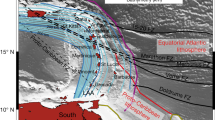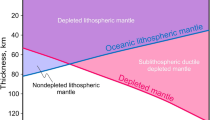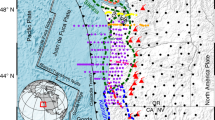Abstract
Water is returned to Earth’s interior at subduction zones. However, the processes and pathways by which water leaves the subducting plate and causes melting beneath volcanic arcs are complex; the source of the water—subducting sediment, altered oceanic crust, or hydrated mantle in the downgoing plate—is debated; and the role of slab temperature is unclear. Here we analyse the hydrogen-isotope and trace-element signature of melt inclusions in ash samples from the Cascade Arc, where young, hot lithosphere subducts. Comparing these data with published analyses, we find that fluids in the Cascade magmas are sourced from deeper parts of the subducting slab—hydrated mantle peridotite in the slab interior—compared with fluids in magmas from the Marianas Arc, where older, colder lithosphere subducts. We use geodynamic modelling to show that, in the hotter subduction zone, the upper crust of the subducting slab rapidly dehydrates at shallow depths. With continued subduction, fluids released from the deeper plate interior migrate into the dehydrated parts, causing those to melt. These melts in turn migrate into the overlying mantle wedge, where they trigger further melting. Our results provide a physical model to explain melting of the subducted plate and mass transfer from the slab to the mantle beneath arcs where relatively young oceanic lithosphere is subducted.
This is a preview of subscription content, access via your institution
Access options
Subscribe to this journal
Receive 12 print issues and online access
$259.00 per year
only $21.58 per issue
Buy this article
- Purchase on Springer Link
- Instant access to full article PDF
Prices may be subject to local taxes which are calculated during checkout



Similar content being viewed by others
References
Kirby, S. H., Engdahl, E. R. & Villaseñor, A. Warm-slab subduction as a global process. The Cascadia Subduction Zone and related subduction systems–Seismic structure, intraslab earthquakes and processes, and earthquake hazards. USGS Open-File Rep. 328, 79–80 (2002).
Wada, I. & Wang, K. Common depth of slab-mantle decoupling: Reconciling diversity and uniformity of subduction zones. Geochem. Geophys. Geosyst. 10, 1–36 (2009).
Wilson, D. S. The Juan de Fuca plate and slab—isochron structure and Cenozoic plate motions. USGS Open-File Rep. 328, 9–12 (2002).
Rondenay, S., Abers, G. A. & Van Keken, P. E. Seismic imaging of subduction zone metamorphism. Geology 36, 275–278 (2008).
Abers, G. A. et al. Imaging the source region of Cascadia tremor and intermediate-depth earthquakes. Geology 37, 1119–1122 (2009).
Van Keken, P. E., Hacker, B. R., Syracuse, E. M. & Abers, G. A. Subduction factory: 4. Depth-dependent flux of H2O from subducting slabs worldwide. J. Geophys. Res. 116, B01401 (2011).
Till, C. B., Grove, T. L. & Withers, A. C. The beginnings of hydrous mantle wedge melting. Contrib. Mineral. Petrol. 163, 669–688 (2012).
Ruscitto, D. M., Wallace, P. J., Johnson, E. R., Kent, A. J. R. & Bindeman, I. N. Volatile contents of mafic magmas from cinder cones in the Central Oregon High Cascades: Implications for magma formation and mantle conditions in a hot arc. Earth Planet. Sci. Lett. 298, 153–161 (2010).
Ruscitto, D. M., Wallace, P. J. & Kent, A. J. R. Revisiting the compositions and volatile contents of olivine-hosted melt inclusions from the Mount Shasta region: Implications for the formation of high-Mg andesites. Contrib. Mineral. Petrol. 162, 109–132 (2011).
Le Voyer, M., Rose-Koga, E. F., Shimizu, N., Grove, T. L. & Schiano, P. Two contrasting H2O-rich components in primary melt inclusions from Mount Shasta. J. Petrol. 51, 1571–1595 (2010).
Plank, T., Kelley, K. A., Zimmer, M. M., Hauri, E. H. & Wallace, P. J. Why do mafic arc magmas contain ∼4 wt% water on average? Earth Planet. Sci. Lett. 364, 168–179 (2013).
Shaw, A. M., Hauri, E. H., Fischer, T. P., Hilton, D. R. & Kelley, K. A. Hydrogen isotopes in Mariana Arc melt inclusions: Implications for subduction dehydration and the deep-Earth water cycle. Earth Planet. Sci. Lett. 275, 138–145 (2008).
Leeman, W. P., Tonarini, S., Chan, L. H. & Borg, L. E. Boron and lithium isotopic variations in a hot subduction zone—the southern Washington Cascades. Chem. Geol. 212, 101–124 (2004).
Borg, L. E., Clynne, M. A. & Bullen, T. D. The variable role of slab-derived fluids in the generation of a suite of primitive lavas from the southernmost Cascades. Can. Mineral. 35, 425–452 (1997).
Borg, L. E., Blichert-Toft, J. & Clynne, M. A. Ancient and modern subduction zone contributions to the mantle sources of lavas from the Lassen Region of California inferred from Lu–Hf isotopic systematics. J. Petrol. 43, 705–723 (2002).
McDonough, W. F. & Sun, S. S. The composition of the Earth. Chem. Geol. 120, 223–253 (1995).
Cooper, L. B. et al. Global variations in H2O/Ce: 1. Slab surface temperatures beneath volcanic arcs. Geochem. Geophys. Geosyst. 13, 1–27 (2012).
McCrory, P. A., Blair, J. L., Waldhauser, F. & Oppenheimer, D. H. Juan de Fuca slab geometry and its relation to Wadati-Benioff zone seismicity. J. Geophys. Res. 117, 1–16 (2012).
Cozzens, B. D. & Spinelli, G. A. A wider seismogenic zone at Cascadia due to fluid circulation in subducting oceanic crust. Geology 40, 899–902 (2012).
Wilson, C. R., Spiegelman, M., van Keken, P. E. & Hacker, B. R. Fluid flow in subduction zones: The role of solid rheology and compaction pressure. Earth Planet. Sci. Lett. 401, 261–274 (2014).
Schmidt, M. W. & Poli, S. Experimentally based water budgets for dehydrating slabs and consequences for arc magma generation. Earth Planet. Sci. Lett. 163, 361–379 (1998).
Hermann, J. & Spandler, C. J. Sediment melts at sub-arc depths: An experimental study. J. Petrol. 49, 717–740 (2008).
Gaetani, G. A., O’Leary, J. A., Shimizu, N., Bucholz, C. E. & Newville, M. Rapid reequilibration of H2O and oxygen fugacity in olivine-hosted melt inclusions. Geology 40, 915–918 (2012).
Bucholz, C. E., Gaetani, G. A., Behn, M. D. & Shimizu, N. Post-entrapment modification of volatiles and oxygen fugacity in olivine-hosted melt inclusions. Earth Planet. Sci. Lett. 374, 145–155 (2013).
Newman, S., Epstein, S. & Stolper, E. Water, carbon dioxide, and hydrogen isotopes in glasses from the ca. 1340 AD eruption of the Mono Craters, California: Constraints on degassing phenomena and initial volatile content. J. Volcanol. Geotherm. Res. 35, 75–96 (1988).
Poreda, R., Schilling, J. G. & Craig, H. Helium and hydrogen isotopes in ocean-ridge basalts north and south of Iceland. Earth Planet. Sci. Lett. 78, 1–17 (1986).
Taran, Y. A., Pokrovsky, B. G. & Volynets, O. N. Hydrogen isotopes in hornblendes and biotites from Quaternary volcanic rocks of the Kamchatka-Kurile Arc. Geochem. J. 31, 203–222 (1997).
Giggenbach, W. F. Isotopic shifts in waters from geothermal and volcanic systems along convergent plate boundaries and their origin. Earth Planet. Sci. Lett. 113, 495–510 (1992).
Wada, I., Behn, M. D. & Shaw, A. M. Effects of heterogeneous hydration in the incoming plate, slab rehydration, and mantle wedge hydration on slab-derived H2O flux in subduction zones. Earth Planet. Sci. Lett. 353, 60–71 (2012).
Connolly, J. A. D. The geodynamic equation of state: What and how. Geochem. Geophys. Geosyst. 10, 1–19 (2009).
Wannamaker, P. E. et al. Segmentation of plate coupling, fate of subduction fluids, and modes of arc magmatism in Cascadia, inferred from magnetotelluric resistivity. Geochem. Geophys. Geosyst. 15, 4230–4253 (2014).
Liu, K., Levander, A., Zhai, Y., Porritt, R. W. & Allen, R. M. Asthenospheric flow and lithospheric evolution near the Mendocino Triple Junction. Earth Planet. Sci. Lett. 323, 60–71 (2012).
Alt, J. C. et al. Recycling of water, carbon, and sulphur during subduction of serpentinites: A stable isotope study of Cerro del Almirez, Spain. Earth Planet. Sci. Lett. 327, 50–60 (2012).
Plank, T. Constraints from thorium/lanthanum on sediment recycling at subduction zones and the evolution of the continents. J. Petrol. 46, 921–944 (2005).
Davis, A. S., Clague, D. A., Cousens, B. L., Keaten, R. & Paduan, J. B. Geochemistry of basalt from the North Gorda segment of the Gorda Ridge: Evolution toward ultraslow spreading ridge lavas due to decreasing magma supply. Geochem. Geophys. Geosyst. 9, 1–24 (2008).
Grove, T., Parman, S., Bowring, S., Price, R. & Baker, M. The role of an H2O-rich fluid component in the generation of primitive basaltic andesites and andesites from the Mt. Shasta region, N. California. Contrib. Mineral. Petrol. 142, 375–396 (2002).
Jicha, B. R. et al. Isotopic and trace element constraints on the petrogenesis of lavas from the Mount Adams volcanic field, Washington. Contrib. Mineral. Petrol. 157, 189–207 (2009).
Mullen, E. K. & Weis, D. Evidence for trench-parallel mantle flow in the northern Cascade Arc from basalt geochemistry. Earth Planet. Sci. Lett. 414, 100–107 (2015).
Skora, S. & Blundy, J. High-pressure hydrous phase relations of radiolarian clay and implications for the involvement of subducted sediment in arc magmatism. J. Petrol. 51, 2211–2243 (2010).
Spandler, C. & Pirard, C. Element recycling from subducting slabs to arc crust: A review. Lithos 170, 208–223 (2013).
Defant, M. J. & Drummond, M. S. Derivation of some modern arc magmas by melting of young subducted lithosphere. Nature 347, 662–665 (1990).
Klimm, K., Blundy, J. D. & Green, T. H. Trace element partitioning and accessory phase saturation during H2O-saturated melting of basalt with implications for subduction zone chemical fluxes. J. Petrol. 49, 523–553 (2008).
Jégo, S. & Dasgupta, R. Fluid-present melting of sulfide-bearing ocean-crust: Experimental constraints on the transport of sulphur from subducting slab to mantle wedge. Geochim. Cosmochim. Acta 110, 106–134 (2013).
Workman, R. K. & Hart, S. R. Major and trace element composition of the depleted MORB mantle (DMM). Earth Planet. Sci. Lett. 231, 53–72 (2005).
Donnelly, K. E., Goldstein, S. L., Langmuir, C. H. & Spiegelman, M. Origin of enriched ocean ridge basalts and implications for mantle dynamics. Earth Planet. Sci. Lett. 226, 347–366 (2004).
Shaw, A. M. Long-term preservation of slab signatures in the mantle inferred from hydrogen isotopes. Nature Geosci. 5, 224–228 (2012).
Hauri, E. H. SIMS analysis of volatiles in silicate glasses, 2: isotopes and abundances in Hawaiian melt inclusions. Chem. Geol. 183, 115–141 (2002).
Hauri, E. H. et al. Matrix effects in hydrogen isotope analysis of silicate glasses by SIMS. Chem. Geol. 235, 352–365 (2006).
Loewen, M. W. & Kent, A. J. Sources of elemental fractionation and uncertainty during the analysis of semi-volatile metals in silicate glasses using LA-ICP-MS. J. Anal. Atom. Spectrom. 27, 1502–1508 (2012).
Acknowledgements
We thank A. Kent (Oregon State University) for assistance with the LA-ICP-MS measurements, J. Wang for support in the Carnegie SIMS lab, and T. Plank and J. Lowenstern for helpful discussions. Financial support was provided by the National Science Foundation (grants EAR-1119224 and EAR-1019848) and the Carnegie Institution of Washington.
Author information
Authors and Affiliations
Contributions
M.A.C., K.J.W. and P.J.W. collected samples, K.J.W. and E.H.H. acquired the geochemical data, I.W. carried out the thermal model calculations. I.W. and K.J.W. performed the fractionation model calculations. All authors participated in writing, revision and interpretation of the data for the manuscript.
Corresponding author
Ethics declarations
Competing interests
The authors declare no competing financial interests.
Supplementary information
Supplementary Information
Supplementary Information (PDF 1286 kb)
Supplementary Information
Supplementary Information (XLSX 32 kb)
Rights and permissions
About this article
Cite this article
Walowski, K., Wallace, P., Hauri, E. et al. Slab melting beneath the Cascade Arc driven by dehydration of altered oceanic peridotite. Nature Geosci 8, 404–408 (2015). https://doi.org/10.1038/ngeo2417
Received:
Accepted:
Published:
Issue Date:
DOI: https://doi.org/10.1038/ngeo2417
This article is cited by
-
An introductory review of the thermal structure of subduction zones: III—Comparison between models and observations
Progress in Earth and Planetary Science (2023)
-
Understanding subduction infancy to mature subduction in Southwest Japan via the self-consistent formation of a weak slab interface
Scientific Reports (2023)
-
Crustal storage and ascent history of the Mt. Shasta primitive magnesian andesite: implications for arc magma crustal flux rates
Contributions to Mineralogy and Petrology (2022)
-
Temporal variations in the diversity of primitive melts supplied to the Santorini silicic magmatic system and links to lithospheric stresses
Contributions to Mineralogy and Petrology (2022)
-
Tracing the subducting Pacific slab to the mantle transition zone with hydrogen isotopes
Scientific Reports (2021)



